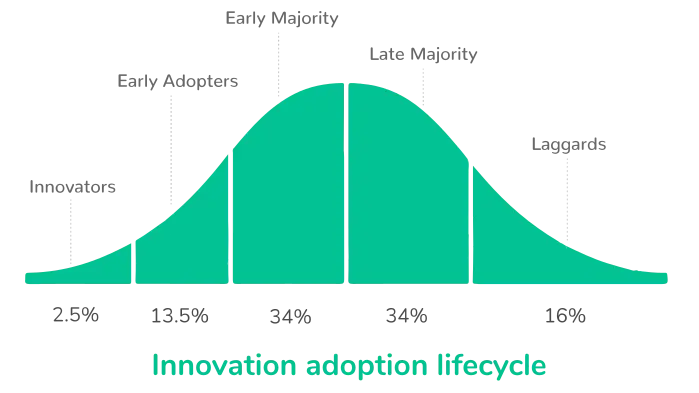SaaS businesses who understand their audience are in a much better position to succeed than those customers who ignore their target customers. Knowing your customers is important in convincing them your product has value.
Customers who adopt new technology like SaaS come in all sorts of shapes and sizes. It’s possible to plot a trajectory of customers who have certain attributes that would be willing to try your product during different stages of its life cycle.
This model is known as the Product Adoption Curve. There are some customers who will go out of their way to adopt a new product first, while others will delay becoming users of a new product until the very last second.
It’s worth tracking the Product Adoption Curve because different segments of customers require varying strategies to attract their business. If you can tailor your product marketing for each stage of the curve, you’ll have a higher chance of achieving widespread adoption.
Product Adoption Definition
Understanding product adoption is necessary before we can move into exploring the Product Adoption Curve. You need to show users of your software the value they can gain from consistently using it.
There are four stages to product adoption:
- Awareness
- Interest
- Evaluation
- Conversion
It doesn’t matter how many users sign up to your product or how many daily users it has unless they are truly successful with your software. Your product should become such an irreplaceable part of their daily life that they can’t imagine going on without it.
Product adoption takes place when the value that your software offers outweighs any temptation users might have to trial a competing product. While it’s important to acquire new customers, you must continue to retain existing customers with new features and compelling offers.
What Is the Product Adoption Curve?
Now, the Product Adoption Curve is a model that captures who is buying your product and when they are buying it. You can use it to make predictions about the life cycle of your product and target your messaging to make it more relevant.
The Product Adoption Curve is represented as a bell curve, which shows the percentage of customers who are adopting your product as it stretches out over time. It’s split up into five phases which we’ll go into now.

Innovators
The Innovators are the smallest segment of the Product Adoption Curve and they are most likely to try new products. They don’t even care if the product is complete, as long as they have a new toy they can play with and can establish their status as being ahead of the crowd.
Innovators are technical users who are even happy with products that have lots of bugs. This makes them an important source of early feedback, although on the negative side they are not willing to pay premium prices for new products – they prefer to get them at a discount or for free.
Early Adopters
The Early Adopter phase represents a much bigger segment than the Innovators, and you’ll know you have reached this stage when your sales start to rise. Early Adopters are also keen to trial new SaaS products, although they need the seal of approval from Innovators before they’ll take the risk to sample your new technology.
These folks may know about your product for some time but they’ll wait a while before they jump on board. They’re typically looking to solve a real-world problem with your software, and so will be much less accepting of technical issues and more demanding of your support team.
Early Majority
The Early Majority phase of the Product Adoption Curve is one of the biggest segments and represents large profits for your SaaS business. This stage is when your product has proven itself to the market and other customers get the chance to see the Early Adopters being successful.
The product adoption peaks during this stage and after the next phase your product is going to go into a decline. This group doesn’t want to pioneer new technology and they are seeking products that are already popular with a substantial number of users.
Late Majority
The Late Majority is another large customer segment who are late to the party when it comes to adopting new technology. At this time, the adoption of your product is slowing down but this is still a substantial user base that you can attract to trial your software.
The Late Majority users are averse to change and they don’t have the budgets to try new technology that they won’t end up using. They want it to be proven that a product works before they will even consider using it. They will usually adopt new technology when it hurts them not to do so.
Laggards
Laggards are the last consumer group to adopt new technology and usually trend towards being older. They are uncomfortable with technology in general and very risk-averse. They prefer to stick with their tried and tested ways of doing things and will only change when their accepted technologies are no longer available to them.
Although you may not be excited to attract Laggards, they make up a higher market share than Innovators and Early Adopters combined, so they could be an important source of revenue for your business.
Product Adoption Life Cycle
Along with the user groups of the Product Adoption Curve, the adoption of a product also goes through changes as the industry and market evolves. Understanding where you are in the life cycle means SaaS companies can adapt their position to maximize product adoption.
Introduction
The stage in which a product is introduced to the market involves it being a relatively well-kept secret. Only small numbers of consumers know about it and it only appeals to Innovators and Early Adopters.
Growth
Now a product starts to sell and become adopted at a much faster rate, thanks to the word-of-mouth and positive reviews from your Early Adopters and Innovators. The Minimum Viable Product (MVP) starts to become mainstream and turn into a viable solution for an increasing number of users.
Maturity
The product is now at its peak of adoption and is competing with alternative solutions on the market for market share. This is when the Early Majority and the Late Majority start using the product and it gains significant traction.
Decline
This is the point where the product reaches saturation in its user base and sales go into decline or stagnate. You’ll find that the Laggards discover your product at this point because everyone else is already using it.
Schedule a demo with one of our experts to take a deeper dive into Churn360
Book a demo
Product Adoption Process
So when you’ve managed to get your various customer segments interested in your product, you need to become aware of the exact product adoption process they will go through when being introduced to your SaaS. This usually happens in five stages.
1. Product Awareness
The customer first becomes aware of your product and they want to find out more information about it. Advertising, marketing, word-of-mouth and publicity all play a role here in generating awareness for your SaaS.
2. Product interest
Customers are already interested in your product and they are receptive to more information about it. They are making a big decision about whether they want to pursue your product any further.
3. Evaluation of the product
In this stage your customer can sample the software such as through a product demo. They are actively comparing your product to its competitors and deciding whether it is worth the investment.
4. Trial
During the trial phase of the product adoption process customers are trying out your software trying to discover whether it works or not. They are establishing whether the product meets their needs and if the software is useful for them.
5. Product Adoption
The customer finally chooses your product over all other options and becomes a regular user of your software. Your business has made the sale and now the focus moves to customer retention.
Product Adoption Curve Metrics
There are a few metrics you can track to help you understand how your Product Adoption Curve is progressing.
Core action percentage
This is the percentage of your customer base who have used a main feature of your product for the first time.
Time-to-first key action
How long it takes for a new customer to use an existing feature, or how long it takes for an existing customer to adopt a new feature.
Adoption rate
The percentage of new users as compared to the number of all users of your SaaS product.
How Can You Improve SaaS Product Adoption in Each Curve

Innovators
- Build up excitement for your new product with exclusive early access
- Enable them to be first users of your SaaS and spread the news about the product
Early Adopters
- Highlight how your product solves a specific pain-point for these users
- Emphasize that your product is still restricted but building momentum
Early Majority
- Show how your product is a great fit for your target market
- Invest in effective onboarding best practices to show new users how your product can benefit them
Late Majority
- Offer discounts and other incentives to induce these new users to try your product
- Make your product risk-free by using free trials to help users experience value
Laggards
- Position yourself as the market leader and show these potential users that very few people are not using your product
- Strike up partnerships with existing solutions that can help you reach out to this conservative customer base
Wrapping Up
The Product Adoption Curve helps your SaaS business decide how to market its product to these very different customer segments. When you tailor your messaging, your product is more likely to strike a chord with potential customers and you’ll move successfully through the product adoption life cycle.
Most important of all, your SaaS business needs to continually innovate in order to stay relevant to an evolving type of customer. It’s natural for a product to reach maturity and then slide into a decline, which is why it’s so critical to keep releasing new features to keep pace with demand.
Customers who are engaged with your product will organically spread the word about your SaaS and keep the excitement growing. If your product is a great fit for your target market, it’s simply a case of customizing your strategy to reach each customer segment.


